Tasio Bidegain (b. 1996, Menorca)
an interdisciplinary artist focused on the creation of visual narratives. Graduated in 2020 from the Rietveld Academie, he is now based in Amsterdam.
Raised in Paris where he autonomously developed several independent artistic practices — painting, drawing, video, and photography — as a quotidian way to react and reflect on his surroundings, an instinct that remains present in his work methods.
His practices have been converging into the creation of large scale scenes through the means of graphite drawings and etchings on photography, leading him to establish his very own pictorial technique and language.
Presently, his work focuses on merging analogue and digital images together into crafted scenes that can carry complex narratives. Aiming to create new visual ways of describing the intricate facets of reality and, in an attempt to synthesise his personal experience of the chaotic world, Tasio’s work always resonates with the intricacy of the contemporary issues faced by his generation.
He is the recipient of the 2020 RM Photo Talent Prize, awarded by Eelco van der Lingen, director of the Mondriaan Fonds.
His works have been exhibited in Amsterdam at Stedelijk Museum, Arti et Amicitiae, FOAM Museum, Galerie Ron Mandos, Het HEM, Unseen; in Paris at Citée Internationale des Arts, Galerie Bertrand Grimont;
in Prague at Campus Hybernska; in New York at Shrine Gallery & Sargent’s Daughter; and have been included in the ABN AMRO Collection and private collections.
2022; group exhibition; Beyond Innocence, Stedelijk Museum Vianen, Vianen, NL
2021; group exhibition; Power of Art, ABN Amro headquarters, Amsterdam, NL.
2021; group exhibition; Oblivion, Private Space, Paris, FR.
2021; group exhibition; Unseen Art Fair, Galerie Ron Mandos, Amsterdam, NL.
2021; duo exhibition; A Hard Rain is Gonna Fall; Galerie Cons, Rotterdam, NL.
2021; group exhibition; Startpoint Prize; Arti et Amicitiae, Amsterdam, NL.
2021; group exhibition; 100 Seconds to Midnight; Espace Marais Marais, Paris, FR.
2020; group exhibition; Startpoint Prize; Kampus Hybernska, Prague, CZ.
2020; group exhibition; Best of Graduates; Het HEM, Amsterdam, NL.
2020; group exhibition; Best of Graduates, Gallery Ron Mandos, Amsterdam, NL.
2020; duo exhibition; Unseen at the Galleries; Gallery Caroline O’Breen, Amsterdam, NL.
2020; group exhibition; Rietveld Graduation Photography; FOAM Museum, Amsterdam, NL.
2020; group exhibition; Noorderlicht Festival; Museum Belvédère, Heerenveen NL.
2020; group exhibition; Graduation Show; Gerrit Rietveld Academie, Amsterdam, NL.
2020; group exhibition; Re-learning Images; Punt WG, Amsterdam, NL.
2019; group exhibition; 5 Academies; Citée Internationale des Arts, Paris, FR.
2019; group exhibition; Vincent op Vrijdag; Van Gogh Museum, Amsterdam, NL.
2019; group exhibition; Velvet Ropes; Shrine Gallery & Sargent’s Daughter, New York, US.
2019; group exhibition; Frazzled Fictions; Art Hotel Gallery, Amsterdam, NL.
2019; group exhibition; Take a Walk on the Wild Side; Stedelijk Museum, Amsterdam, NL.
2019; group exhibition; Homards; Galerie Bertrand Grimont, Paris, FR.
2018; group exhibition; Perreo Sutil; ASPA Galeria, Madrid, ES.
2018; group exhibition; Cringe, the Anticipation of Touch; Stedelijk Museum, Amsterdam, NL.
2018; group exhibition; Mal Élevés; La quincaillerie, Brussels, BL.
2017; duo exhibition; Ce Soir J’Oublie Tout; Galerie des 3 Bornes, Paris, FR.
2017; group exhibition; Les Demons de Minuit; La Cappella, Paris, FR.
2016; group exhibition; Fragments; Galerie des 3 Bornes, Paris, FR.
Permanent Collections
2020; ABN AMRO Art Collection; Amsterdam, NL.
2019; Museo Talavera de la Reyna; Puebla, MX.
Send an e-mail, or visit on Instagram.
And the Eye Caught on Fire
is a monumental graphite drawing depicting an exterior scene unfolding in the historical canals of Amsterdam and centred around a fictional event, the burning of the EYE museum.
This six meter long drawing can be interpreted as an allegory of our overly interconnected present and proposes a vision of its potential outcomes.
In this uncanny vision of Amsterdam, the different layers of the drawing merge into an oddly familiar yet dreamlike vision of the crowded city-centre in which a multitude of micro-narratives weave this extraordinary scene.
Half of the drawing, resting on the wall, represents the emerged and visible part of the world while the bottom half, laying above the floor level, is the immersed realm of the unconscious, subterranean and invisible forces existing below the city.
Divided into several layers of meaning, the drawing is based on a geometrical structure that creates a narrative system enabling a dialogue in between the multiple symbols, scenes and protagonists.
From the roots and cables that hold our world together, to the cloud of information laying over our heads, the fresco offers a direct commentary on the Image in it’s present stage of global-digitalisation, in what the philosopher Annie LeBrun refers to as “a dictatorship of visibility”.
The transmutation of organic matter into abstract data via technological means is at the heart of the reflexion behind this piece.
The resulting scene offers a visual representation to the concept of “necropolitics”, a term coined by the post-colonialist historian from Cameroun Achile Mbembe and later used and transformed by Paul B. Preciado in their writings under the form of “necrocapitalisme” or ”necroliberalism”. The concept, rooted in Foucault’s Thanatopolitique, designates a social system in which governance is based on techniques of death or violence.
Indeed the overload of trash and objects laying at the feet of the characters in the foreground, next to a figure who appears to be sleeping under the crowd is a grim reminder of the discarded images that our world produces.
The old city, populated by its esoteric symbols and entangled buildings, slowly grows to form an intricate mechanical complex where the industrial buildings of the outskirts of Amsterdam, the chemical refineries and their chimneys are absorbed into this mass of information and disappear under a menacing dark cloud.
Above the city lies a tower, piercing through the sky and referencing the depictions of the biblical Babel, or the 16th major arcana of the tarot: the Tower or Maison Dieu, who, stroked by lightning, symbolises the violent destruction of masks and the foreseeing of radical changes. This tower is hence both representative of human power and of its destructive nature.
In fact, this piece could be seen as an ode to life in the face of the apocalypse ( from the greek apokalyptein, meaning to uncover or to reveal) as the characters represented in the drawing seem careless about the impending tragedy as they are caught in their usual habits, some dancing and others hurrying up to work.
Echoing the tradition of artworks using disastrous (from the latin dis-astrum or absence of stars) events as their main subject, such as “The Great Earthquake of Lisbon” by João Glama Ströberle in 1755 or the Great Fire of London of 1666 painted by Granger, the cataclysmic scene imagined by Tasio sets it’s scenery in near-future Amsterdam.
Following this universal human fascination for the depiction of the apocalypse, this piece offers a visual manifestation of the sublime in modern tragedy, as Goya could have done it in his series the disasters of war back in 1810 or John Martin in his epic mythological landscapes such as The Great day of his Wrath.
Hence the delicacy of the graphite drawing in this piece directly speaks to the impermanence of all things.
Exhibited in Amsterdam at Arti et Amicitiae.
 And the Eye Caught on Fire, 600 x 200, graphite on paper, 2021.
And the Eye Caught on Fire, 600 x 200, graphite on paper, 2021.
 Detail of And the Eye Caught on Fire, middle left.
Detail of And the Eye Caught on Fire, middle left.
 Detail, middle middle.
Detail, middle middle.
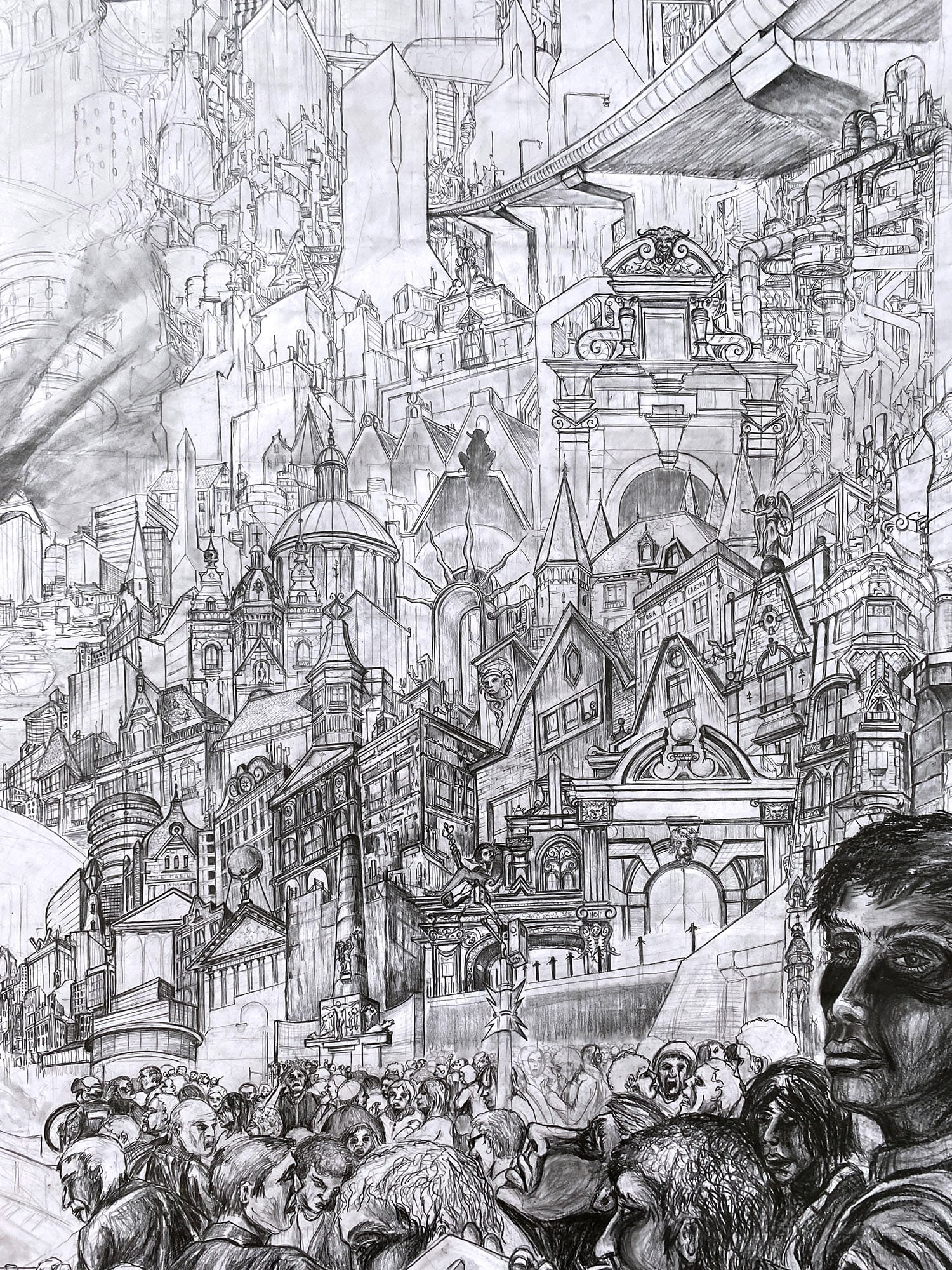 Detail, middle right.
Detail, middle right.
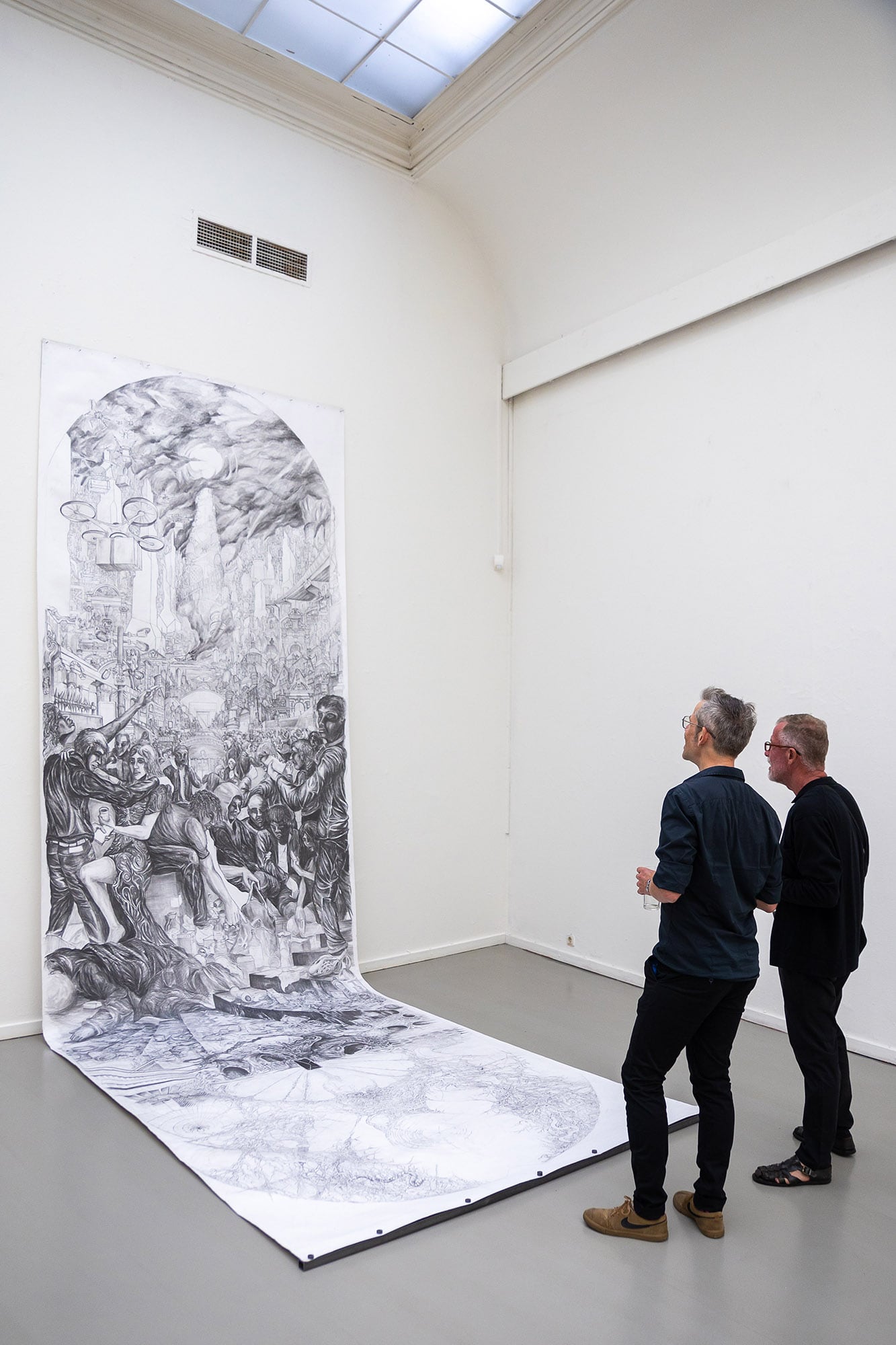 Exhibition view of And the Eye Caught on Fire as presented at Arti et Amicitiae, September 2021.
Exhibition view of And the Eye Caught on Fire as presented at Arti et Amicitiae, September 2021.
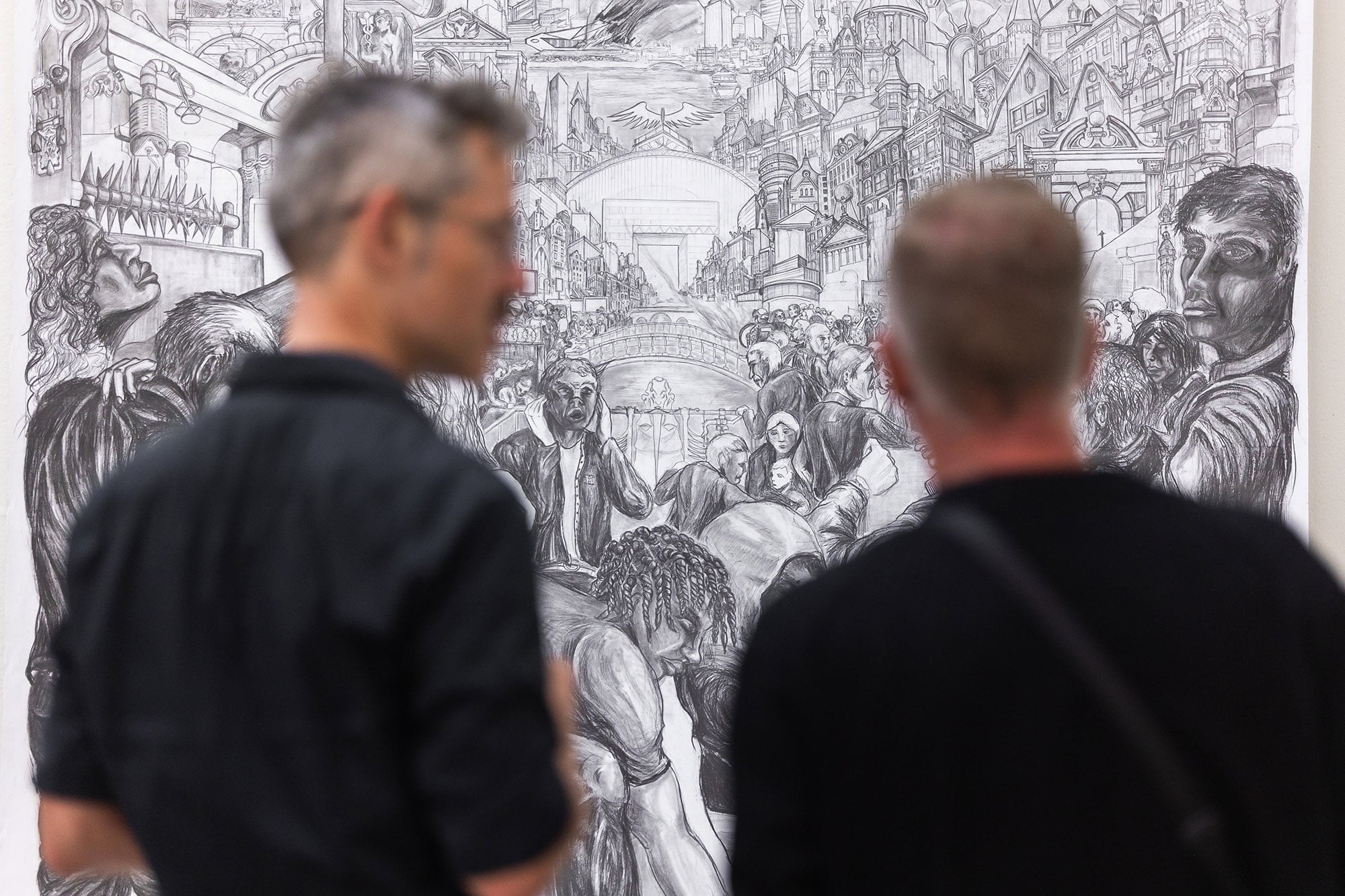
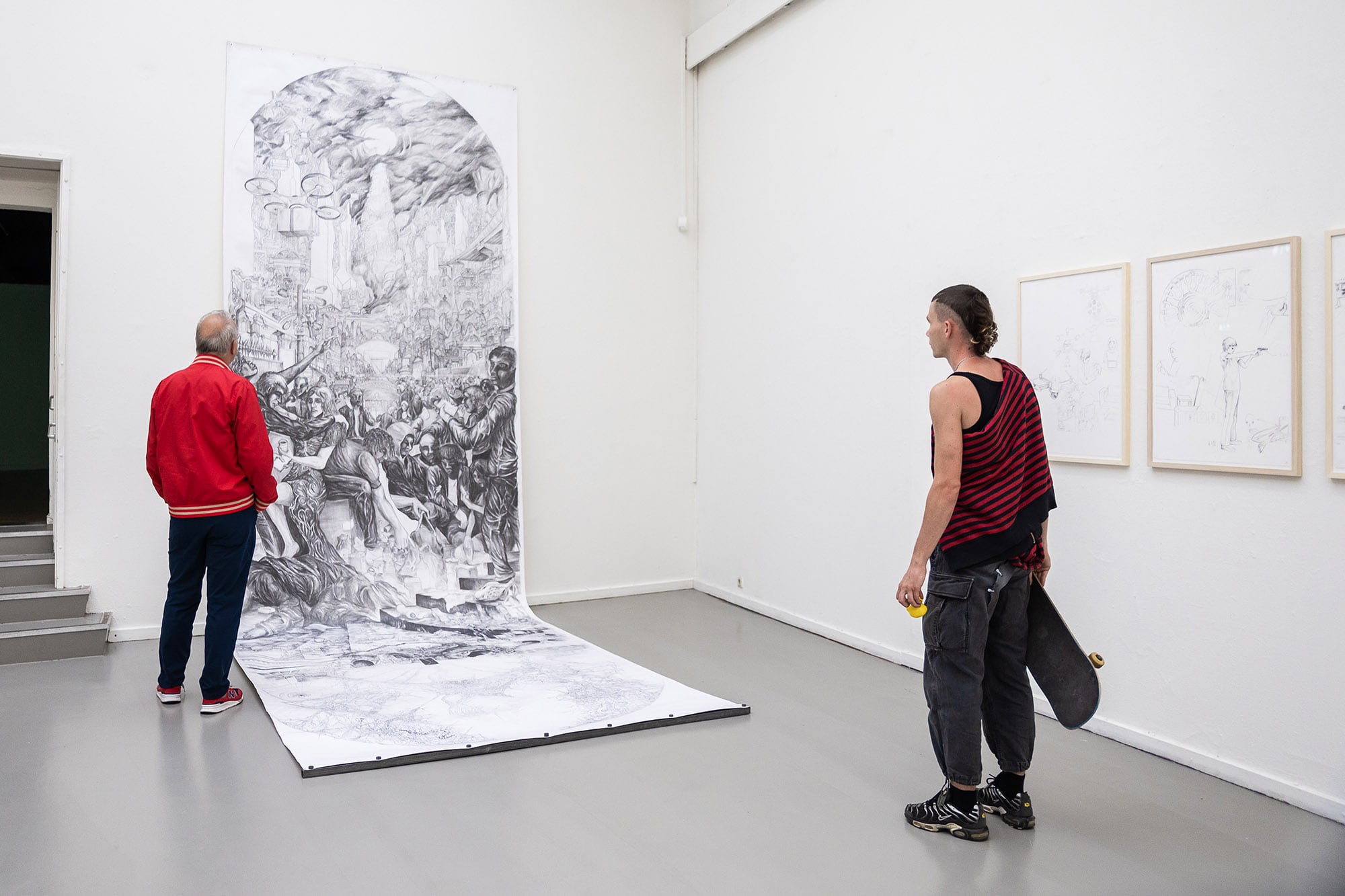 Exhibition views.
Exhibition views.
Meeting at the Crossroad
is a painting by Benoit Gilles Michel and Tasio Bidegain. The result of this collaboration manifested in a cross-shaped triptych. The three panels of 122 x 244 cm OSB plywood are painted with acrylic and silicone and mounted on steel frames.
Benoit Gilles Michel is a sculptor and video-artist, born in Guadeloupe, he studied product design in Paris before moving to Amsterdam. His work questions spiritual traditions in a modern context, assembling symbols and images to create his narratives in which transpires the mysteries and the beauty of his birthplace.
Tasio Bidegain, born in the island of Menorca, is a drawer and visual artist who grew up in Paris and studied photography in Amsterdam, where he is now based. His monumental drawings are reflections of the world as he experiences it, swarming with stories and characters evolving in an world that transforms organic life into data.
Tasio and Benoit Gilles met in Amsterdam in September 2020 where they started an ongoing dialogue of images and ideas that would soon link their artistic practices, leading them amongst other projects to the creation of this painting in between April and June 2021.
In their studio space, an old shipyard by the industrial docks of the city, the two young artists started reflecting on the use of symbols, with the purpose of creating a visual story that could encompass both their separate experiences and their encounter in this precise place and time.
They understood that the story of this painting was about two individual opposites using their differences in order to create a common mythology.
Because no matter how different they seemed, they shared a vision and worked in a common perspective so that their references, their journeys and their ideas could be reflected in their work.
They believed that their paths had crossed here for a reason, coming from two islands across different oceans, it’s by the port of a city of Amsterdam that this unexpected encounter occurred.
From a distance, the triptych seems like a huge green cross out of which rich and terrible landscapes appear as one gets closer to the paintings.
A huge swamp, swarming of creatures and symbols unfolds in front of the viewer along a curved horizon line that borders the menacing sky.
In the central panel, on the vertical axis of the cross, a spiral staircase reaches up to the clouds. This staircase is made of 18 spheres, one for each of its pointy steps, stretching into elongated thorns and covered in a damier pattern.
Like on a chessboard, the black and white tiles convey the story of a game between life and death, light and darkness.
At the bottom of the staircase, the spheres, reflected and distorted in the swamp’s water, vanish in between the thick roots of the mangrove.
Below, a fugu fish or moon fish is raising its spiky body out of the water, its eyes staring right back at the viewers. It seems to be floating above a whirlpool, spiralling until the extremity of the painting and disappearing into obscurity.
In the left panel of the scene, the sun sets above the sea where a boat sails to the right of the horizon line. Diving into the water, raws of cliffs echo the landscapes of Menorca, the birthplace of Tasio.
The sides of the cliffs are pierced with caves and on top of them, houses overlook the landscape. In the foreground, a twisted leg appears out the rocks, its feet shaped like a lion paw. Black and white corals are standing next to two blooming pita flowers, those plants that only blossom once, right before they die. Surrounded by roots crawling through the swamp, a green goat faces a salamander. Further into the water, a three-legged donkey looks towards the centre of the painting. Red light emanates from the depths of a hollow tree stump on top of which a white snake is crawling down.
The right-hand panel presents a full moon under which light two spirits appear to be shining in the middle of the waters. These two characters are neither angels or demons, in between sirens and winged creatures, their horns and human like faces making them look concerned.
On the top right corner, a chequered-pattern cemetery lies next to a huge fromager, those spiked trees believed to be home to malevolent entities in the Caribbean Islands.
Under the tree, bordering the graves made of seashells, runs a river, its course spiralling down to reach the middle of the panel. On its banks are stones that appear to have been carved for some forgotten deities.
Out of the roots and reaching to the water, a pair of hoofed legs appear forming two mirrored “6” shapes, a white and a brown one. Hanging from one of the legs, a toad stares across the swampland.
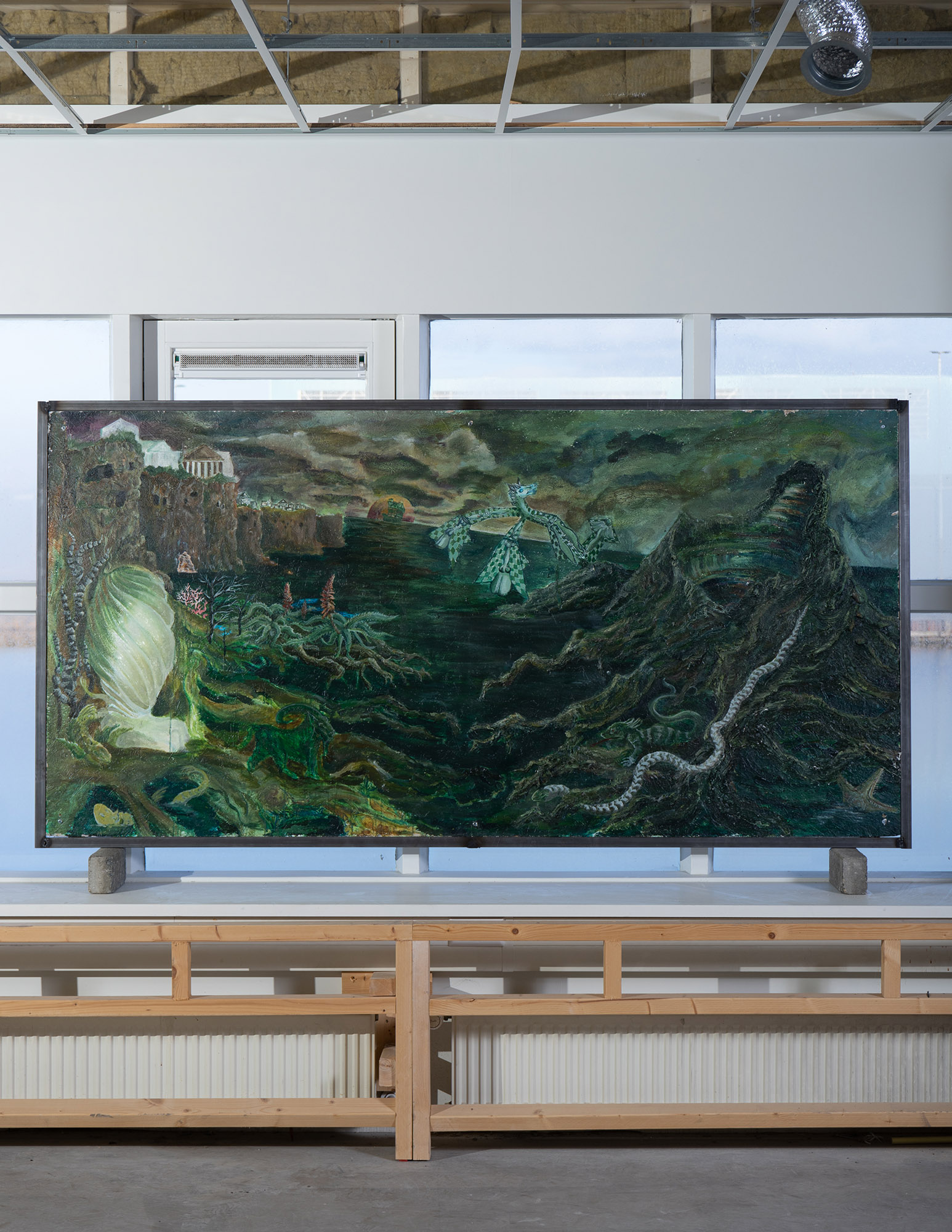 Studio view of Meeting at the Crossroad, mixed media on wood panels and steel frame, left, 2021.
Studio view of Meeting at the Crossroad, mixed media on wood panels and steel frame, left, 2021.
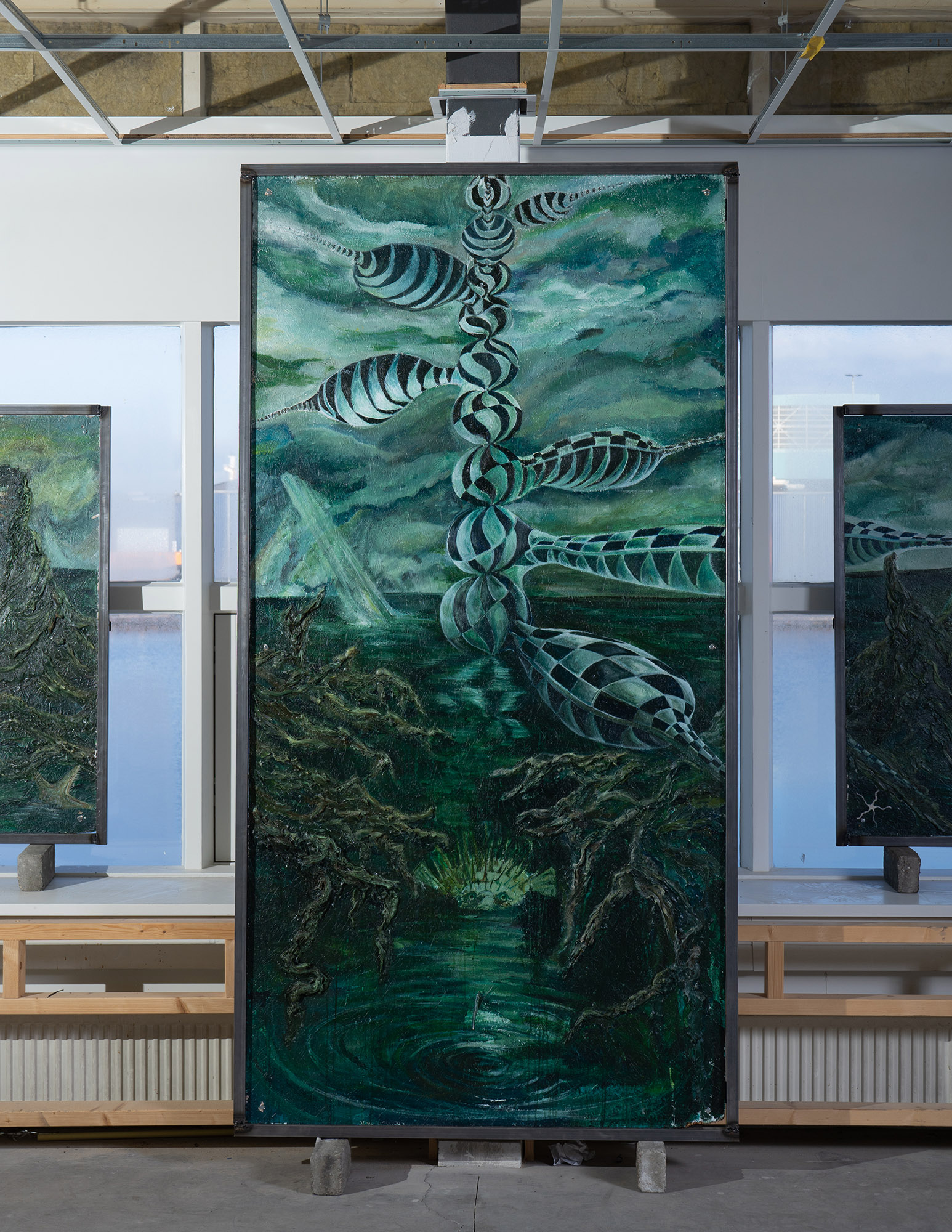 Studio view, middle.
Studio view, middle.
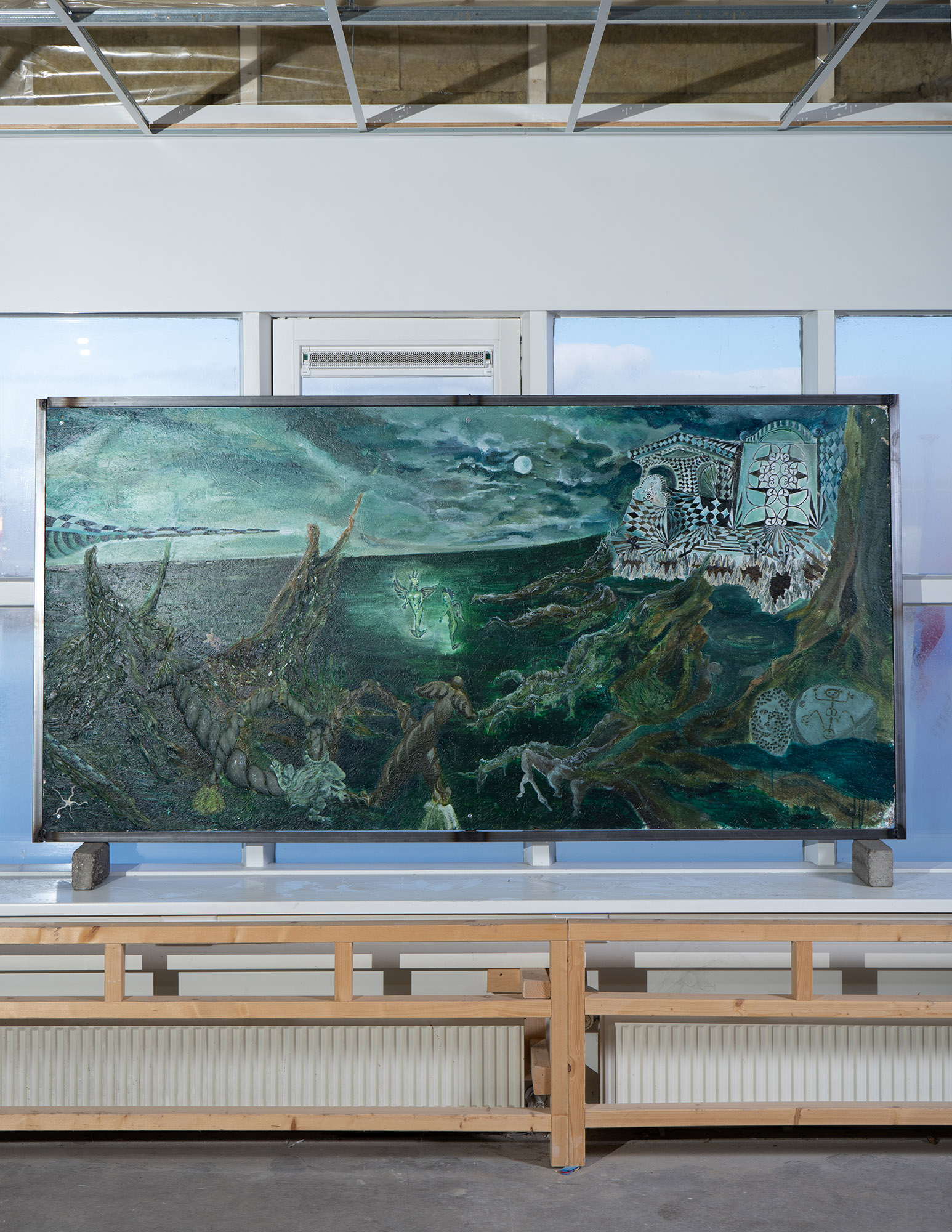 Studio view, right.
Studio view, right.
Paris syndrome
is a photographic publication, for which the artist made more than two-hundred original drawings, gathered within the book and presented in installations.
Created during the first worldwide lockdown following the outbreak of COVID-19 in 2020, this project encapsulates the visual manifestations of this pandemic as witnessed by the artist.
The Paris syndrome is the physical condition exhibited by some individuals while visiting Paris, as a result of an extreme shock when discovering that the city of Paris is not as beautiful as the generally positive representations of the city had led them to expect.
In a broader sense, it is the shock felt by an individual after realising they believed virtual images as being reality itself.
To be witnessing a pandemic of unprecedented scale while confined at home meant that the only ways to experience the full-scale repercussions of this events was either through a screen or a window.
The virtual impressions of this worldwide events drove the artist to extract images out of the storm of visual information he was surrounded by in order to draw and assemble them, hence creating careful, precise and intriguing compositions.
The surgical sharpness of Bidegain’s drawings, mimicking the cold, systematic, and unsparing tone of the information cycle, contrasts with the enchanted reality of the pictures, weaving a constellation of modern narratives. In those 'confined' photographs, taken in the empty streets or inside the monotony of an apartment, the banality of our routine, trash, flowers, or buildings suddenly reveals an appealing and chimerical glow.
Images from news media, advertisement, social media, and scientific data merges together to create a dystopian yet oddly familiar vision of this specific moment in time. Screenshots of riots, adds for face-masks, media footage covering the pandemic, classical paintings, and landscapes of cities in ruins are amongst the images that the artist encountered and drew during the worldwide lockdown for the series Paris Syndrome.
Starting with visions of modern cityscapes, the book ends with images of the ruins of Paris, as to suggest a narrative arch throughout the book and perhaps a cyclical idea of time. That can be observed in the conclusion of the book, where images of the CERN’s circular particle collider clash with religious representations from various civilisations, inducing a strong visual link in-between science and spirituality.
All of the screenshots used to create the drawings are indexed at the end of the book, serving as a reference guide through the narrative.
The release of the book Paris syndrome was accompanied by the publication of the poster titled Stay Home, play more, which assembles some of the original drawings from the book in an intricately detailed digital patchwork.
Exhibited in Amsterdam at Arti et Amicitiae, FOAM Museum, Galerie Caroline O’Breen, Galerie Ron Mandos, Gerrit Rietveld Academie Graduation Show, Het HEM, Unseen at the Galleries; and in Prague at Campus Hybernska.
Works from this series have been included in the ABN AMRO Collection and private collections.
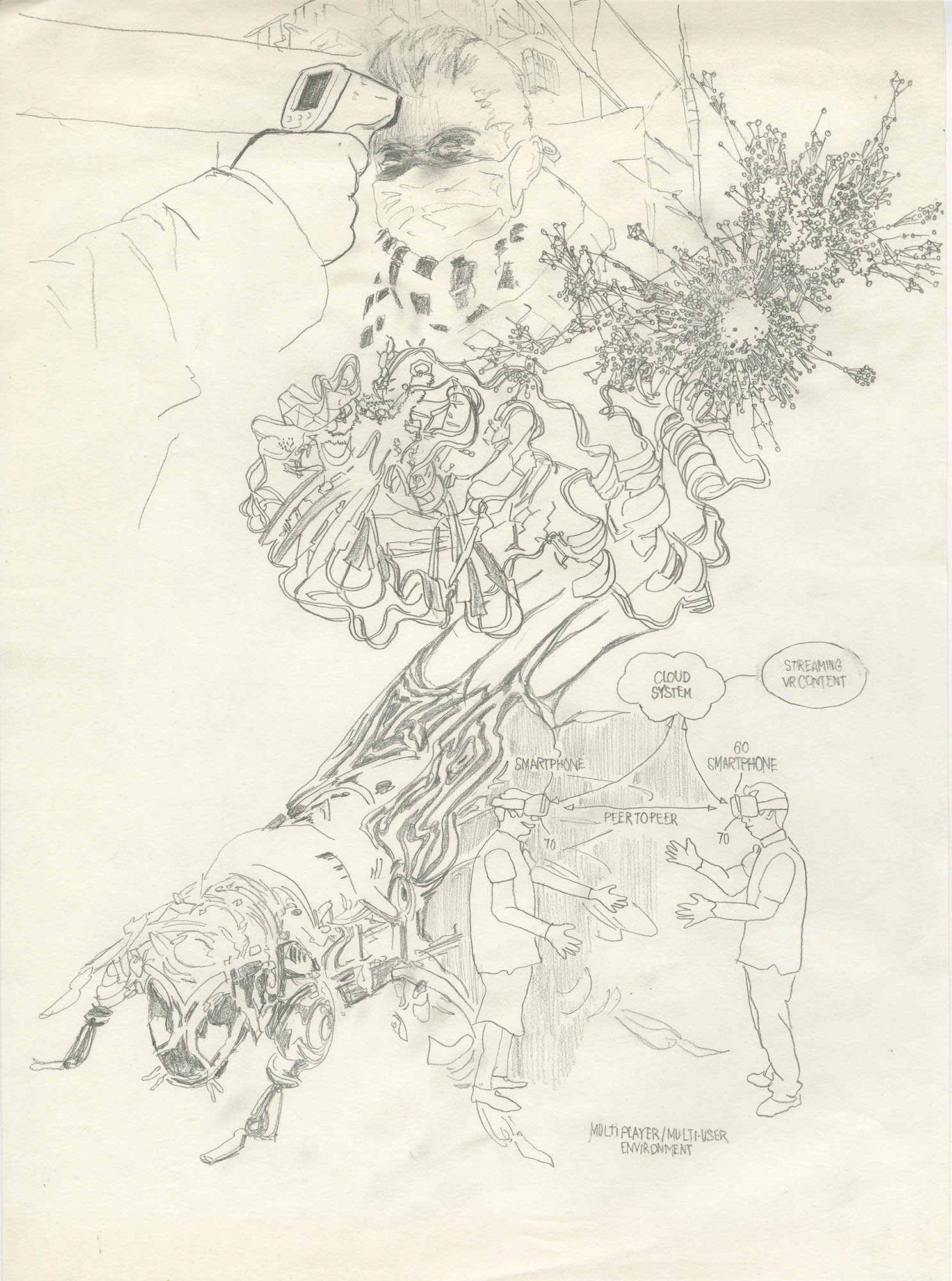 Original drawing from the Paris syndrome series: Temperature’s rising, 297 x 420 mm, graphite on paper. Private collection.
Original drawing from the Paris syndrome series: Temperature’s rising, 297 x 420 mm, graphite on paper. Private collection.
 Installation view of eighteen original drawings from the Paris syndrome series and in-situ mural intervention as presented at FOAM Museum Amsterdam, October 2020. Courtesy of the ABN AMRO art collection.
Installation view of eighteen original drawings from the Paris syndrome series and in-situ mural intervention as presented at FOAM Museum Amsterdam, October 2020. Courtesy of the ABN AMRO art collection.

 Installation view of ten original drawings and in-situ mural intervention as presented at Galerie Ron Mandos, November 2020.
Private Collection.
Installation view of ten original drawings and in-situ mural intervention as presented at Galerie Ron Mandos, November 2020.
Private Collection.
 Original drawing from the series: Bedroom, graphite on paper.
Original drawing from the series: Bedroom, graphite on paper.
 Original drawing from the series: Living room, graphite on paper.
Original drawing from the series: Living room, graphite on paper.
 Original drawing from the series: Couple, graphite on paper.
Original drawing from the series: Couple, graphite on paper.
 Book cover Paris syndrome. 220 pages, 210 x 297 mm, 220 pages, digital print, first edition of 15 copies, July 2020.
Book cover Paris syndrome. 220 pages, 210 x 297 mm, 220 pages, digital print, first edition of 15 copies, July 2020.

 Spreads from the book Paris syndrome.
Spreads from the book Paris syndrome.
 Poster Stay home, play more. 841 x 1189 mm, digital print, first edition of 7 copies, July 2020.
Poster Stay home, play more. 841 x 1189 mm, digital print, first edition of 7 copies, July 2020.
Corners of my room
is a unique triptych, hand-carved on photographic prints. It represents the room where the artist created this work between December 2019 and January 2020.
With this work, the artist seeks to organise and understand the shapeless storm of information unleashed upon the world by the digital era. A vision of an era where private images merge with the anonymous mass of public images without distinction, where we experience the complexity of the world through a screen, while being in a closed-off room. It is as if the artist's vision in this work already hinted at the transformations that the soon-to-follow COVID-19 pandemic would cause.
The particular way in which the photographic elements and drawings merge together is induced by the unusual technique of carving and etching, aided by chemicals, directly onto a print that the artist has been developing over the years. The eight photographs forming the triptych depict modern still lives in which screens, cables, fruits and plastic create an intriguing and surreal landscape.
Tied to the tradition of Dutch and Spanish still-life painting, but also to product photography, the artist's dreamy images are a first comment on a consumerist system idolising objects.
Historically, traditional still lives would evolve through time, mirroring the changes the world was undergoing. From the simple and austere vanitas paintings locally known as bodegones in the Spanish tradition and the breakfast pieces in the Dutch one, the paintings that used to symbolise the ephemerality of material things and their transitional nature, memento mori (Latin: “remember you will die”) soon became a testament of the opulence created by colonialist tread. Rare spices, good, animals or silverware started to appear in extravagant compositions that spoke to the wealth of the companies who would acquire them. This genre — though not critically acclaimed — was highly popular. It later became the basis for what we now know as the advertising industry, as most of the still-lives created today are for the purpose of selling objects (commercial photography, pack shots, 3D animations and renderings, and so on). In this sense, The artist's approach to the subject manifests the tension between art and advertisement while producing a dream-like composition of objects emerging from the darkness of the image in a soft chiaroscuro.
Looking closer at the work, two main figures emerge on the left- and right-hand panels. One is facing a butterfly and carries a sun while the other faces an upside down-moth and holds a crescent moon in her hand. This dual symbolism and play with opposites appears all throughout the triptych, which seem to reveal new secrets with each viewing.
References to the art world can also be identified amongst the drawings such as a semi-circular line at the bottom of the triptych that appears to carry ten of the world’s most expensive paintings, from Picasso to Gauguin and with Da Vinci’s Salvator Mundi occupying a central place in the work. At both ends of this half-circle, art auctions at Sotheby’s and Christie’s can be seen, closing the cycle of artworks as most expensive and powerful objects.
Exhibited in Amsterdam at Punt WG; and in Heerenveen at Museum Belvédère.


 (top) Corners of my room, 278 x 188 cm, etching and chemicals on photograph, 2020.
(top) Corners of my room, 278 x 188 cm, etching and chemicals on photograph, 2020.
(middle) Installation view of Corners of my room, as presented at Museum Belvédère during the Noorderlicht Photography Festival, July – September 2020.
(bottom) Installation view, as presented at Punt WG during the exhibition Re-learning images, January – September 2020.

 (top) Detail of Corners of my room, right panel, middle.
(top) Detail of Corners of my room, right panel, middle.
(bottom) Detail, right panel, left.
 Detail, right panel, right.
Detail, right panel, right.
 Detail, central panel, top.
Detail, central panel, top.
Into the swarm
is the collection of the artist’s nine first works made using the etching-on-photograph technique in 2019.
Like monsters in a child’s closet, marvelous scenes emerge from the image’s blackest shadows and get lost in the shiny reflections of the print resembling the enchanting lights of the city. Viewers can sometimes glimpse at their own reflection projected onto glossy paper on which the drawings are traced. This opaque yet reflective surface strangely reminds one of the screen of a smartphone representing both the a mirror and a window to another reality.
The flat photographic print is carved, burned, etched with bleached and chemicals to become an object that reflects love and decay as the artist witnesses it.
Throughout the pieces, the artist creates a complex narrative arch that assembles modern and traditional symbols to create visions of potential futures.
The objects present in the photographies can be carefully composed studio compositions as well as quick snapshots taken in the streets. The drawings appearing on top of those photographs seem to be the unconscious expressions and narratives hidden within the pictures. Each individual etching focuses on a specific topic while maintaining a strong semantic link to the other pieces. Every one of them proposes a modern vision of classical subjects: digital love, a virtual Tower of Babel, a Thinker facing a storm of information are amongst the figures encountered throughout the series.
Reinterpretations of classical myths can be found scattered all over the several works. Some examples are Ophelia surrounded by plastic waste, Narcissus looking down on a phone, Venus and Michelangelo's David as transsexual holograms, Madonna and Child sponsored by Amazon, Botticelli’s Primavera fades into a 3D-printed orgy. This attention to the classical tradition of symbolism can be found in every one of the works, creating unexpected associations that elude simplistic interpretation.
Exhibited in Amsterdam at Stedelijk Museum ; and in Paris at Citée Internationale des Arts.
 Studio view of Red Bull, 70 x 100 cm, etching and chemicals on photograph, 2021.
Studio view of Red Bull, 70 x 100 cm, etching and chemicals on photograph, 2021.
 Studio view of The cave, 70 x 100 cm, etching and chemicals on photograph, 2021.
Studio view of The cave, 70 x 100 cm, etching and chemicals on photograph, 2021.
 Studio view of In the corner of my room, 70 x 100 cm, etching and chemicals on photograph, 2021.
Studio view of In the corner of my room, 70 x 100 cm, etching and chemicals on photograph, 2021.
 Studio view of The cave, 70 x 100 cm, etching and chemicals on photograph, 2021.
Studio view of The cave, 70 x 100 cm, etching and chemicals on photograph, 2021.
 Like volcano, 73 x 110 cm, etching and chemicals on photograph, 2019.
Like volcano, 73 x 110 cm, etching and chemicals on photograph, 2019.
 Alone in the room, 73 x 110 cm, etching and chemicals on photographic, 2019.
Alone in the room, 73 x 110 cm, etching and chemicals on photographic, 2019.
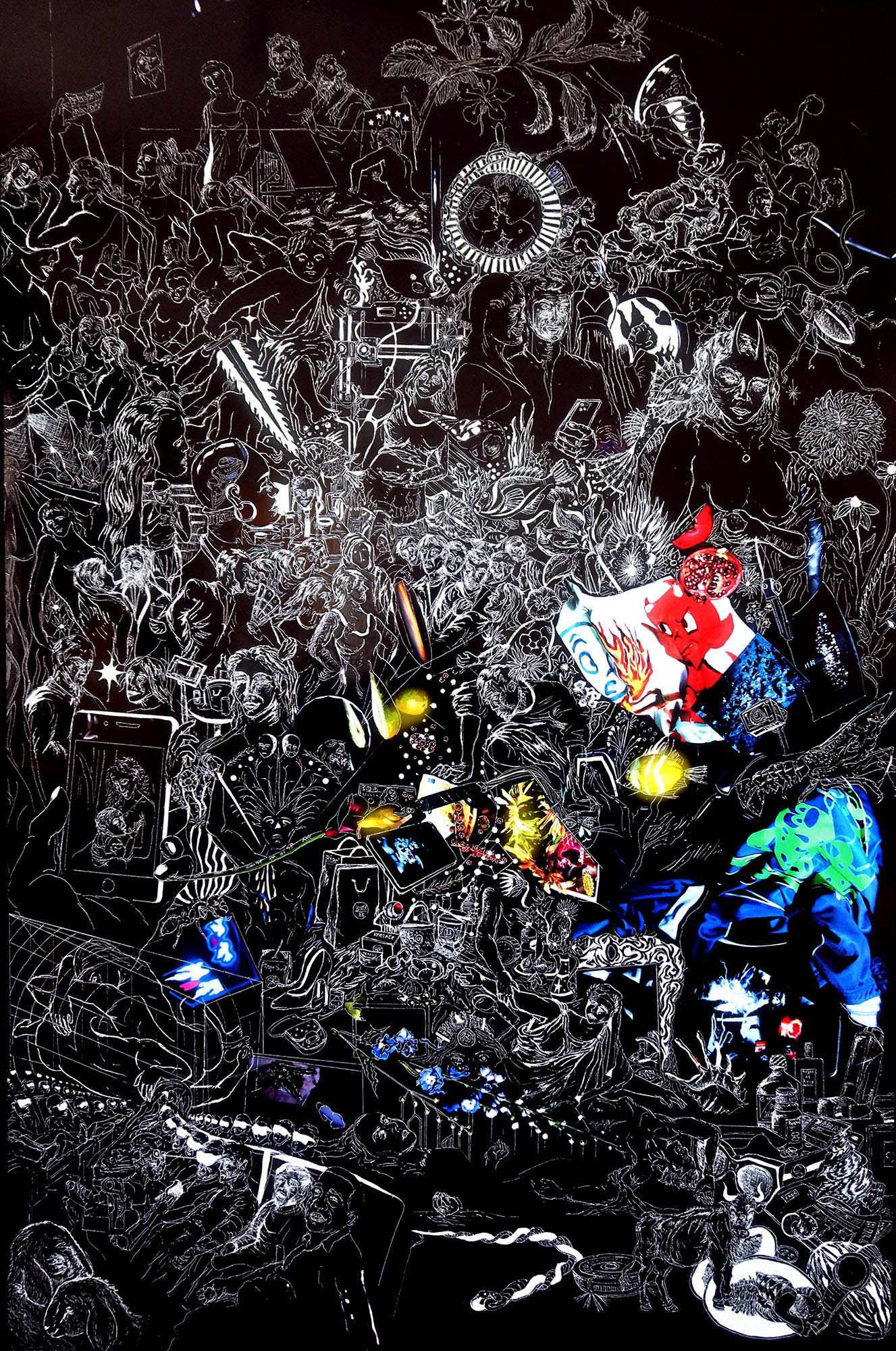 Hoy y siempre, 73 x 110 cm, etching and chemicals on photograph, 2019.
Hoy y siempre, 73 x 110 cm, etching and chemicals on photograph, 2019.


 Installation views of eight unique etching-on-photograph works from the Into the swarm series, as presented at the Citée Internationale des Arts, November 2019.
Installation views of eight unique etching-on-photograph works from the Into the swarm series, as presented at the Citée Internationale des Arts, November 2019.
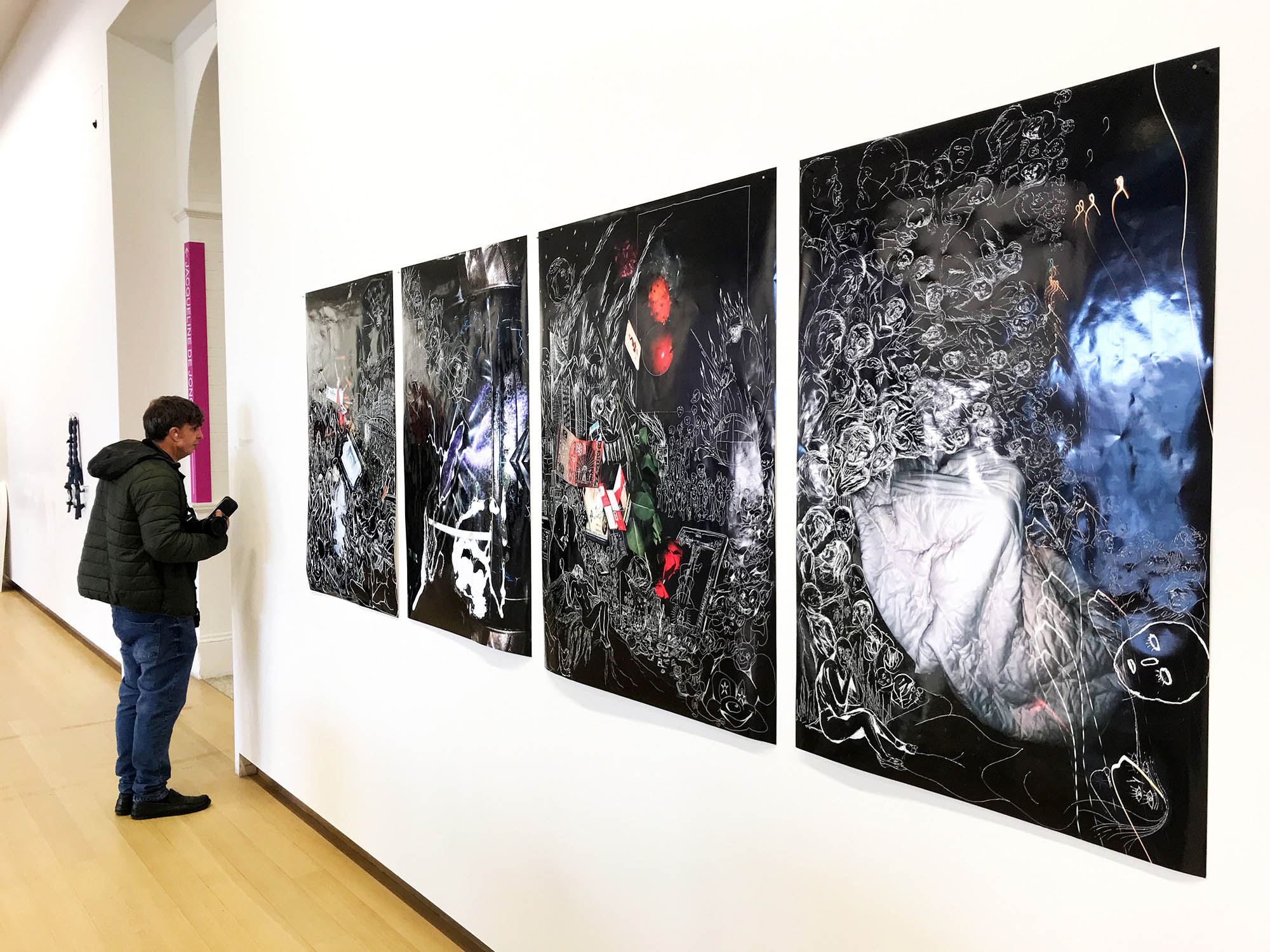
 Installation views of four unique etching-on-photograph works from the Into the swarm series, as presented at the Stedelijk Museum, March 2020.
Installation views of four unique etching-on-photograph works from the Into the swarm series, as presented at the Stedelijk Museum, March 2020.
Evening in Stalingrad
is a monumental scene of over ten meters long and three meters high, the carefully constructed panorama is divided in ten individual panels and was drawn over a three-month period in 2018.
It depicts a nightmarish party in the north-east of Paris, on the infamous Stalingrad Square.
The Stalingrad Square is a particular place in Paris, central to the crack traffic since the ’90s, it is built around a circular building resembling a temple, but after the revolution and formerly a tax collecting center, it is now a hyped-up Parisian night club. This building known as la Rotonde is located in-between the entrance of the northern Canal de l’Ourcq and the Paris Métro Line 2. Around the building the square extends for some distance before reaching an elevated circular promenade under which you can see small obscure tunnels. This square, its tunnels, and elevated walks have for over 30 years been considered the ‘crack supermarket’ of Paris. Police vehicles are posted on the square every day, mostly a symbolic gesture that has never hindered the theater of misery unfolding on the square.
At the very heart of this grim square lies a hyped club, symbolic of the gentrification taking place in the neighbourhood and creating the conditions for the strange mixture of luxury and misery, joy and hatred, and decadence and survival.
The twenty-four human figures in the foreground appear to be caught in a dance that has accents of struggle. The faces are scared, amazed, tortuous and passionated alike. At the bottom of the scene lie an assortment of objects — trash and litter, typical for the streets of Paris. From these objects flames arise that merge with the human scale figures in the middle section of the piece.
Behind the twenty-four figures lies the endless city, swarming with bodies in a broken and deconstructed perspective that transforms the cityscape into an impenetrable maze with, at its very center, the building of la Rotonde. Far in the distance, the smoke of a burning cathedral meets the top of the brutalist projects of Paris under the darkness of the night sky.
The scene carries many references to classical art history such as the Noces de Cana and the Last Supper. The composition of the scene as well as its numerical characteristics establish a vivid connection with the tradition of occult geometry in visual arts.
 Installation view of Evening in Stalingrad, 10 x 3 m, mixed media on paper, 2019.
Installation view of Evening in Stalingrad, 10 x 3 m, mixed media on paper, 2019.
 Portrait of the artist in front of Evening in Stalingrad.
Portrait of the artist in front of Evening in Stalingrad.
 Detail of cityscape from Evening in Stalingrad, from left: third section, top half.
Detail of cityscape from Evening in Stalingrad, from left: third section, top half.
Colourful money
is a series of three unique black-and-white prints, each of them drawing out a tension between photographs depicting currency and drawings of still lives.
Europe is famously known for the colours of its money: purple five-hundreds, yellow two-hundreds, green hundreds, orange fifties, blue twenties, red tens, and grey fives. The US, on the other hand, is the land of green money, with the exception of the hundred dollar bills and their blue tones referred to as the Blue Benjamin’s or sea notes.
All over popular culture the colour of money and its symbolism is used to create images, from songs to movies, modern art, and advertising. Colourful money is the artist’s attempt to create a modern still life based around the concept and visual manifestations of money's physical forms.
In this black and white take on the classical canon of vanitas, the artist renders this opulent and vibrant composition of symbolically significant objects in a monotone way.
The absence of colour in this series creates an austere atmosphere that aims to challenge the baroque and charged arrangement of objects.
Luxury items are standing next to common objects of the every day life — sneakers, fruits, sprite bottles, or precious antique jars are all scattered on the prints, amongst dead and living creatures, insects and icons.
 Installation view of Colourful Money, 44 x 110 mm, three unique prints, 2018.
Installation view of Colourful Money, 44 x 110 mm, three unique prints, 2018.
 Detail view of Colourful Money, first.
Detail view of Colourful Money, first.
 Detail view of Colourful Money, second.
Detail view of Colourful Money, second.
 Detail view of Colourful Money, third.
Detail view of Colourful Money, third.
Talavera ceramics
is a collaboration between Tasio Bidegain and Itziar Domingo during a residency at the atelier Talavera de la Reyna, in Puebla, Mexico.
During the course of two months, the duo worked in a traditional Talavera ceramic workshop in Puebla, Mexico. The collaboration resulted in the creation of more than a hundred pieces, all designed and hand-painted by the artists in accordance to the traditional technique of Talavera, dating back to the 9th century.
From June to August 2018, they started learning and producing traditional ceramics with a modern vision, inspired by the popular culture they witnessed in Mexico, the colours found in advertisements and nature, the joy and sadness to be found in the ubiquity of their symbolisms.
Restrictions of colours and material came into play when conceiving this series of objects. With the original ceramic painting particular to the Talavera de la Reyna, it is only possible to make use of six different pigments, all extracted and handmade by the local workers. The brushes, made of the hairs of the mule tale, were irregular and stiff, making it difficult to master the technique but also creating the unique circumstances allowing for the production of this series.
The ceramics produced in the atelier were subsequently presented in an installation at the Van Gogh Museum during an event curated by Itziar Domingo.
Works from this series have been included in the permanent collection of the Talavera de la Reyna Museum in Puebla.
 Breakfast in Ziuatanejo, 60 x 40 cm, Talavera pigments on ceramic, 2018. In collaboration with Itziar Domingo.
Breakfast in Ziuatanejo, 60 x 40 cm, Talavera pigments on ceramic, 2018. In collaboration with Itziar Domingo.
 Detail of Breakfast in Ziuatanejo.
Detail of Breakfast in Ziuatanejo.
 Tasio's Coca-Cola, 70 x 70 cm, Talavera pigments on ceramic, 2018.
Tasio's Coca-Cola, 70 x 70 cm, Talavera pigments on ceramic, 2018.
 Detail of Tasio's Coca-Cola.
Detail of Tasio's Coca-Cola.
 Atelier view of hand-painted plates and tiles out of the oven, Talavera pigments on ceramic, 2018. In collaboration with Itziar Domingo.
Atelier view of hand-painted plates and tiles out of the oven, Talavera pigments on ceramic, 2018. In collaboration with Itziar Domingo.
 Cinco besos, 30 x 30 cm, Talavera pigments on ceramic, 2018. In collaboration with Itziar Domingo.
Cinco besos, 30 x 30 cm, Talavera pigments on ceramic, 2018. In collaboration with Itziar Domingo.
 Overview of produced work at the end of the residency.
Overview of produced work at the end of the residency.
Justice nulle part
is a one-channel experimental video installation created by Tasio Bidegain alongside artist and designer Pierre Dufresne from the Panama Papers Office.
This black-and-white video sets a mysterious and uncomfortable atmosphere as crude shots of Paris’ underground world unfold on the screen.
Filmed and edited by the duo, the video depicts several short scenes linking up together in a mosaic of images portraying the visual manifestations of injustice in Paris as witnessed by them.
Derangement and fascination emanate from the images as they unfold. From burning cars to cryptic images of police control and testimonies of migrants, the picture of the city of lights painted by the artists avoids clichés to give a raw insight on the invisible forces that control the city. Giving a place to the unseen and underlaying scenes and bodies that make this capital city so unique is at the heart of the this short experimental film.
Throughout the 3’13” runtime of the movie, the rhythm of the sequences accelerate in a turmoil of violence and frustration, the ambiguity of the images leaves no room for simplistic interpretations: cops and criminals are altogether in world in which justice is nowhere to be found.
This work was made on the occasion of the Uncut Festival at Stedelijk Museum in 2018.
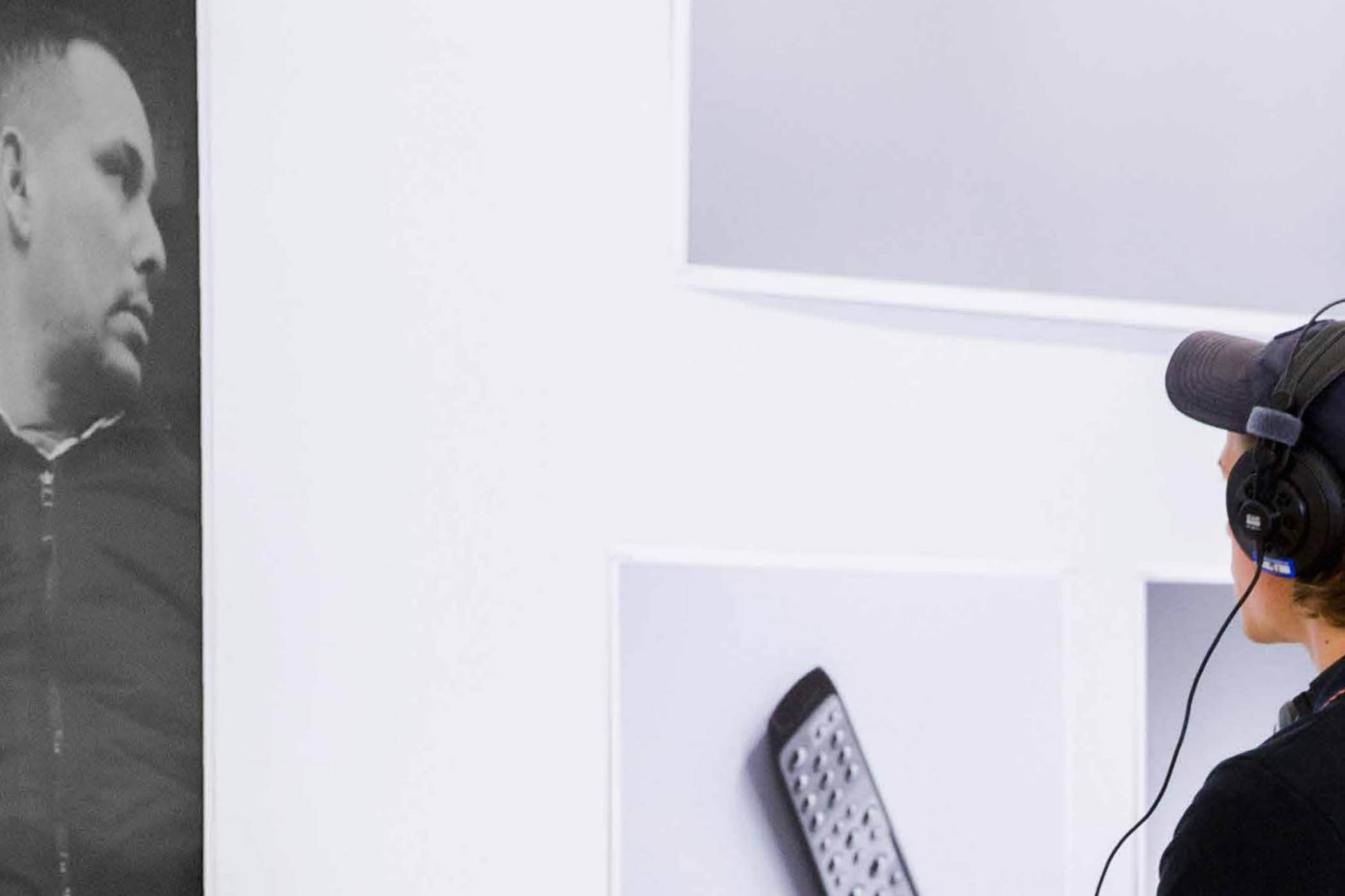
 Installation view of Justice nulle part, 3’13”, short film, at Stedelijk Museum during the Uncut Festival, 2018. In collaboration with Pierre Dufresne.
Installation view of Justice nulle part, 3’13”, short film, at Stedelijk Museum during the Uncut Festival, 2018. In collaboration with Pierre Dufresne.

 Spreads from the exhibition journal of Justice nulle part, 280 x 405 mm, digital print, edition of 50 copies, 2018. In collaboration with Pierre Dufresne.
Spreads from the exhibition journal of Justice nulle part, 280 x 405 mm, digital print, edition of 50 copies, 2018. In collaboration with Pierre Dufresne.
 Poster for Justice nulle part, 400 x 600 mm, offset print, edition of 150 copies, 2018. In collaboration with Pierre Dufresne.
Poster for Justice nulle part, 400 x 600 mm, offset print, edition of 150 copies, 2018. In collaboration with Pierre Dufresne.

 (top) still frame from Justice nulle part, 0’15”,
(top) still frame from Justice nulle part, 0’15”,
(bottom) still frame, 1’30”.

 (top) still frame, 0’45”,
(top) still frame, 0’45”,
(bottom) still frame, 1’45”.
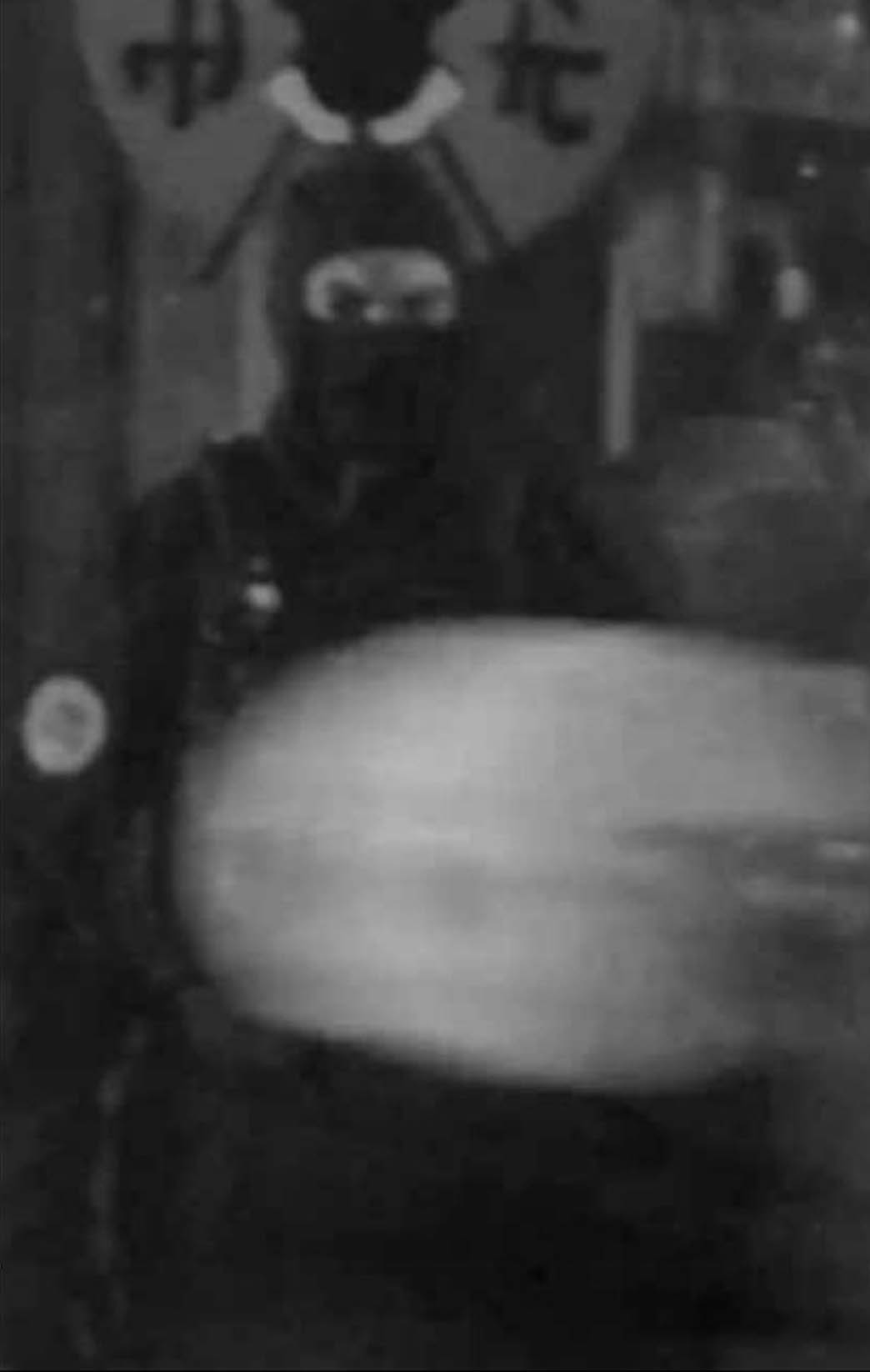
 (top) still frame, 1’00”,
(top) still frame, 1’00”,
(bottom) still frame, 2’00”.

 (top) still frame, 1’15”,
(top) still frame, 1’15”,
(bottom) still frame, 2’30”.
Party in Belleville
is a zinc etching made through the collaborative efforts of Tasio Bidegain and Etienne Clerc. The etching depicts a vision of a party in the metro station of Belleville in Paris, where both of the artists grew up.
The swarming image shows a multitude of scenes, some witnessed and others imagined by the duo, all merging in a dense composition only broken by the right side frame that holds five different permutations of the dance between the Sun and the Moon.
These esoteric pictographs stand in sharp contrast with the highly figurative scenes and alludes to the mystic and sacred ever present in the banalities of daily life.
The piece is a tribute to the chaos and complexity in the north-west of Paris, popular neighbourhoods of the capital in which cultural diversity and narratives are strengthened by their complexity.
 Etching Party in Belleville, 110 x 70 cm, etching on zinc, 2018. In collaboration with Etienne Clerc.
Etching Party in Belleville, 110 x 70 cm, etching on zinc, 2018. In collaboration with Etienne Clerc.

 (top) Detail of Party in Belleville, top left.
(top) Detail of Party in Belleville, top left.
(bottom) Detail, bottom left.

 (top) Detail, top right.
(top) Detail, top right.
(bottom) Detail, bottom right.
Hell on Earth
is an ongoing collaborative engagement between Tasio Bidegain and Etienne Clerc, in which the duo finds ways of depicting contemporary manifestations of Hell.
“Hell is empty and all
the devils are here.”
— William Shakespeare
Throughout a series of visual works encompassing the mediums of painting, drawing, lithography, metal etchings, and so on, the duo investigates various expressions of Hell as understood in Western culture, or to be specific: in Dante’s Inferno.
Vibrant monumental paintings and endlessly detailed drawings are used to depict scenes blurring the line between real and imagined. The use of classical symbolisms mixed with modern objects creates a new mythology in which KFC buckets are served in Purgatory’s banquets.

 (top) Installation view of Hell, 5 x 2 m, acrylic on cotton, 2018. In collaboration with Etienne Clerc.
(top) Installation view of Hell, 5 x 2 m, acrylic on cotton, 2018. In collaboration with Etienne Clerc.
(bottom) Detail of Hell, bottom left.

 (top) Installation view of Ennui, 420 x 297 mm, ink on paper, 2018. In collaboration with Etienne Clerc.
(top) Installation view of Ennui, 420 x 297 mm, ink on paper, 2018. In collaboration with Etienne Clerc.
(bottom) Detail of Ennui, middle.

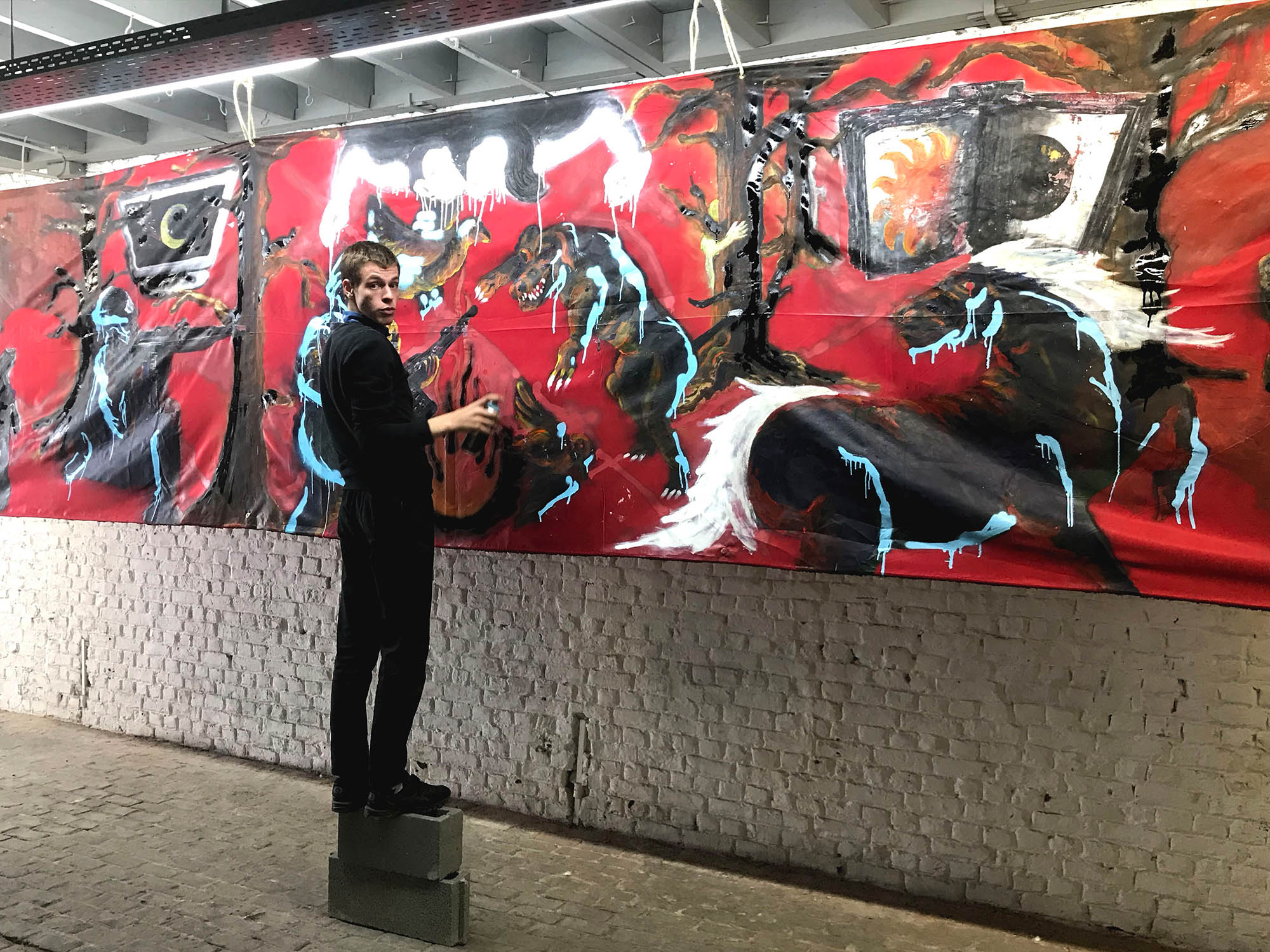 (top) Installation view of The hunting, 6 x 2 m, mixed media on velvet, 2018. In collaboration with Etienne Clerc.
(top) Installation view of The hunting, 6 x 2 m, mixed media on velvet, 2018. In collaboration with Etienne Clerc.
(bottom) Process documentation of The hunting.

 (top) Installation view of New Moon, 10 x 6 cm, lithography on paper, 2018. In collaboration with Etienne Clerc.
(top) Installation view of New Moon, 10 x 6 cm, lithography on paper, 2018. In collaboration with Etienne Clerc.
(bottom) Lithography New Moon.
Website by Helmer Stuyt © 2022